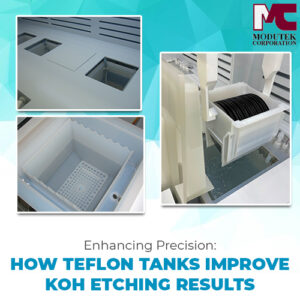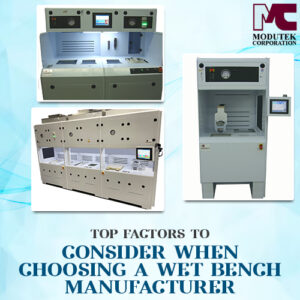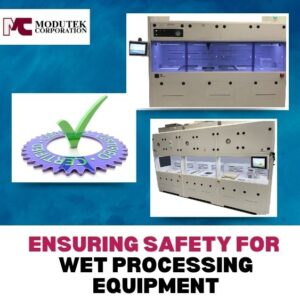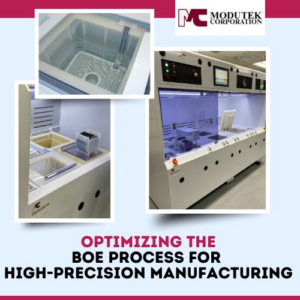![]()
Editor’s Note: This article was originally published in Aug 2019 and has been updated with additional information and reposted in May 2023.
Silicon wet etching is a crucial process used in the semiconductor industry to form various structures and patterns on silicon substrates. Isotropic and anisotropic wet etching techniques are two types frequently used in the industry, each offering distinct benefits and limitations.
Understanding these etching processes’ differences, equipment, and process parameters is essential to achieving desired results. In this article, we will cover the fundamentals of isotropic and anisotropic silicon wet etching processes along with associated equipment used for wet etching as well as process parameters and tradeoffs between them.
Isotropic Silicon wet Etching
Isotropic silicon wet etching is a method that removes material evenly in all directions from a silicon substrate. It’s often used for creating rounded corners or removing material from large areas of the substrate. To accomplish this task, isotropic etchants, such as potassium hydroxide (KOH etching) or tetramethylammonium hydroxide (TMAH etching), are widely utilized in the semiconductor industry.
The advantages of isotropic etching include its ability to produce uniform etch profiles and rapidly remove large amounts of material. Furthermore, isotropic etching can create smooth surfaces on silicon substrates for applications like wafer thinning and polishing.
However, the use of isotropic etching can have drawbacks as well. Without direct control in the etching process, precise structures with sharp corners or defined edges may prove challenging to create. Furthermore, undercutting of the substrate may occur where material from beneath masking layers is removed by the etchant, which leads to an expansion of features beyond their intended boundaries.
In the semiconductor industry, isotropic etching is often utilized for applications like creating through-holes in silicon wafers, creating microlenses for optical applications, and producing thin silicon membranes for pressure sensors. Isotropic etching can also be used to produce microelectromechanical systems (MEMS) devices, where it may create microfluidic channels or remove sacrificial layers.
Anisotropic Silicon Wet Etching
Anisotropic silicon wet etching is a process that selectively removes material from a silicon substrate in one direction, creating well-defined features with sharp corners and edges. This type of etching uses anisotropic etchants that selectively dissolve material along certain crystallographic planes on the silicon substrate.
One commonly-used anisotropic etchant for silicon is a solution that contains nitric acid and hydrofluoric acid (HNO3/HF). This mixture preferentially removes material from the (111) planes of the silicon substrate, creating features with well-defined sidewalls and sharp corners.
Anisotropic etching offers many advantages, such as creating precise structures with well-defined corners and edges, which makes it ideal for applications such as microelectromechanical systems (MEMS) devices and microfluidic channels. Anisotropic etching may also produce gratings for optical applications where precise control over feature dimensions is essential.
The use of anisotropic etching has some drawbacks. The etching process can be slow for deep etches and the rate can depend on the orientation of the silicon substrate. In addition, anisotropic etchants may result in high aspect ratio features being etched, leading to bowing or bending issues in the substrate.
Anisotropic etching is widely utilized within the semiconductor industry for applications including producing precise features for MEMS devices, creating deep trenches for high-density capacitors, and creating grating structures for optical applications. Anisotropic etching can also be used with isotropic etching techniques to form complex three-dimensional structures.
More details on isotropic and anisotropic silicon wet etching can be found in the following documentation:
- Silicon Wet Isotropic and Anisotropic Etching, University of Maryland
- Anisotropic Silicon Etch Using KOH, University of California at Irvine
Comparing Isotropic and Anisotropic Silicon Wet Etching Processes
Isotropic and anisotropic silicon wet etching differ in their mechanisms and surface morphologies. While isotropic etching removes material uniformly in all directions, anisotropic etching preferentially removes material along certain crystallographic planes. The tradeoffs between using isotropic and anisotropic etching depend on the specific application.
Etching Mechanisms: Isotropic etching involves removing material in all directions at an equal rate, creating a rounded profile. Meanwhile, anisotropic etching removes material along specific crystallographic planes, producing sharp corners and edges. Anisotropic etchants allow precise control over the etched features which makes it useful in creating precise structures.
Etched Surface Morphology: While isotropic etching usually produces a smooth surface, anisotropic etching may produce rough surfaces due to exposed crystallographic planes being exposed. In addition, anisotropic etching can create surface defects like hillocks or pits due to these planes being exposed unevenly.
Tradeoffs of Isotropic and Anisotropic Etching: Selecting isotropic versus anisotropic etching will depend on the application requirements. Isotropic etching is an efficient process for producing uniform etch profiles and quickly removing large volumes of material, making it suitable for applications such as silicon wafer thinning and polishing. However, due to lack of directional control during isotropic etching it may be difficult to create precise structures. Anisotropic etching can create precise structures with distinct corners and edges, making it suitable for MEMS devices and microfluidic channels. However, its selectivity often results in slower etching rates and greater aspect ratios, which requires careful consideration of process parameters and equipment when using this method of production.
Wet Etching Process Parameters
Wet etching is a process that relies on a controlled chemical reaction between an etchant and the substrate to achieve the desired etch profile. Controlling the process parameters is key in creating the desired etch conditions which include etch rate, selectivity, and surface roughness characteristics.
Importance of Controlling Process Parameters: Controlling process parameters is essential to achieve consistent and repeatable wet etching results. Even minor fluctuations in temperature, chemical concentration or agitation can significantly affect the etch rate, selectivity, and surface roughness. By carefully managing these process parameters it is possible to achieve the desired etch characteristics and ensure both quality and consistency with the final products.
Commonly Controlled Process Parameters in Wet Etching: There are various process parameters commonly controlled in wet etching, including temperature, agitation, chemical concentration, and pH. Temperature impacts the rate of chemical reaction which in turn determines the selectivity and uniformity of an etch. Agitation serves to ensure the even distribution of etchant across substrate surfaces which in turn helps with the uniformity of an etch. In addition, the chemical concentration and pH can alter the rate, selectivity as well as surface roughness of substrate surfaces.
Effects of Process Parameters on Etch Rate, Selectivity, and Surface Roughness: Careful control of process parameters can have an enormous effect on etch rate, selectivity, and surface roughness of substrates. Increasing the temperature may increase etch rates, but can also decrease selectivity which results in undercutting or etching unwanted features. Increasing agitation may improve uniformity while at the same time increase surface roughness. By carefully controlling the process parameters it is possible to achieve the desired etch characteristics while mitigating any undesirable side effects.
Wet Etching Equipment
Silicon wet etching is a common process used in the semiconductor industry for precisely patterning and shaping silicon substrates. There are several types of equipment needed for silicon wet etching, each offering their own distinct set of features and capabilities.
Types of Equipment Used for Silicon Wet Etching: Three primary forms of wet etching equipment used on silicon are manual wet benches, semi-automatic wet benches, and fully automated wet processing systems. Manual benches typically serve low-volume production applications while semi-automatic and fully automated systems are used for high-volume production environments.
Key Features and Capabilities of Wet Etching Systems: Wet etching systems typically include a chemical tank, temperature control system, wafer carrier, and system for stirring the etchant. Semi-automatic and fully automated systems may also include robotic wafer handling, as well as chemical mixing and dispensing systems and inline metrology equipment for monitoring process parameters. These wet etching systems can also be tailored or customized specifically to accommodate various substrates and etchants and be designed for specific applications, such as deep silicon etching for MEMS devices.
Factors to Consider When Selecting Silicon Wet Etching Equipment: When choosing wet etching equipment, several factors should be considered, including required etch rate, etch profile, selectivity, and uniformity. Other aspects may include processing substrate type, chemical compatibility of the etchant with the equipment, and the level of automation required by the application. Cost is also a significant consideration, which could range anywhere between tens of thousands to millions of dollars depending on system complexity and capabilities.
Modutek’s Equipment Support for Isotropic and Anisotropic Wet Etching Processes
Modutek provides an extensive supply of silicon wet etching equipment to support customers using the isotropic and anisotropic wet etching processes. This includes Modutek’s Teflon tanks which come in temperature-controlled and ambient versions. For processes dependent on temperature for controlling etch rate, the tank temperature controllers provide rapid and accurate heating. In addition, concentrations can be maintained through supplementation of de-ionized water with custom tank sizes if needed. Contact Modutek for a free consultation or quote on selecting the right silicon wet etching equipment to support your etching process requirements.





